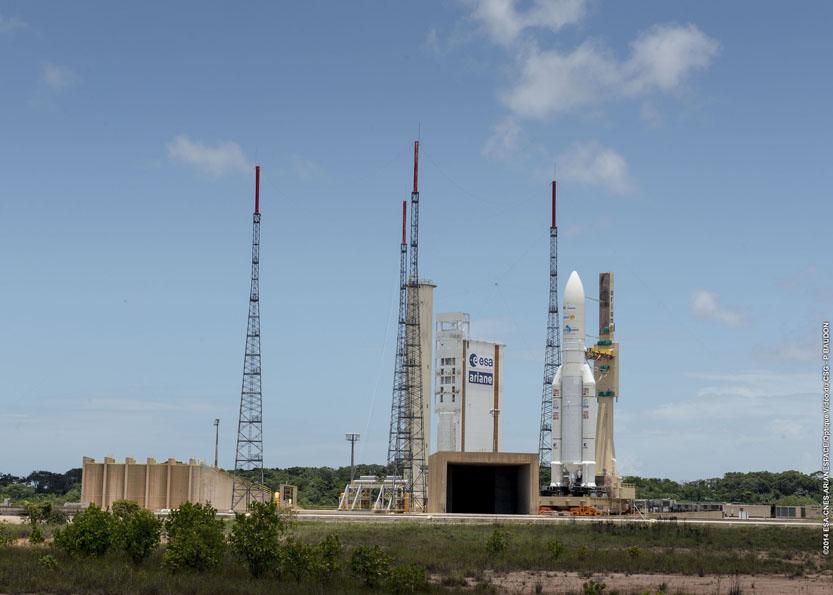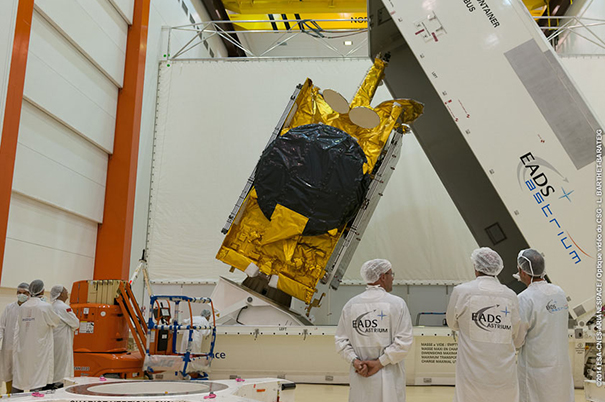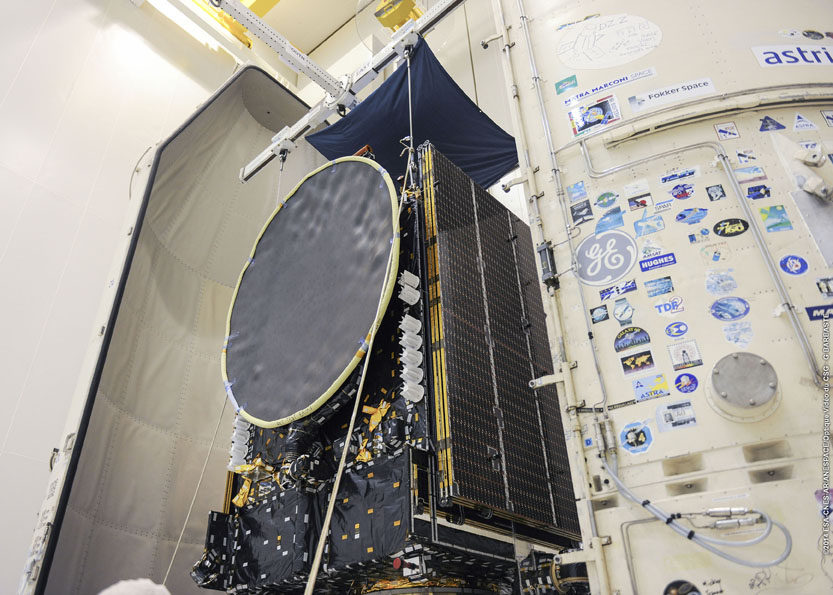Ariane 5 Rocket Set to Launch Two Satellites Today

Two communications satellites for operators in Malaysia and Australia are awaiting liftoff Thursday aboard an Ariane 5 rocket, going for its 75th flight from a tropical launch pad on the shores of South America.
Ground crews transferred the rocket -- resting on a mobile launch platform -- along 1.7 miles of rail tracks Wednesday between the Ariane 5's final assembly building and its launch pad at the Guiana Space Center, a European-run spaceport in Kourou, French Guiana. You can watch the launch live on Spaceflight Now here.
The rocket is carrying the Measat 3b and Optus 10 satellites to broadcast television programming directly to millions of customers across Asia and Australia over the next 15 years. [Amazing Rocket Launch Photos for 2014]
Workers aligned the rocket over the launch pad's flame trench, connected the vehicle to propellant reservoirs, electrical systems and control networks, and verified the Ariane 5 was ready for a final countdown Thursday.
The Ariane 5's launch team will oversee the pumping of super-cold liquid hydrogen and liquid oxygen propellants into the two-stage rocket Thursday, leading up to the opening of a 62-minute launch window at 2121 GMT (5:21 p.m. EDT).

The rocket's Vulcain 2 main engine will fire and build thrust for seven seconds while the Ariane 5 remains on the launch pad, giving computers a chance to confirm the engine's health before igniting two powerful solid rocket boosters.
Once the boosters ignite their pre-packed powder propellant, the Ariane 5 will rise from the launch pad, turn east from the Guiana Space Center, and rocket out over the Atlantic Ocean atop nearly 3 million pounds of thrust.
Get the Space.com Newsletter
Breaking space news, the latest updates on rocket launches, skywatching events and more!
Accelerating across the Atlantic, the Ariane 5 will shed the two boosters -- providing more than 90 percent of the power to get off the ground -- about 2 minutes and 20 seconds after liftoff to fall back into the sea. The rocket's nose shroud will open up and jettison from the launcher in two halves a minute later, while the hydrogen-fueled main stage keeps burning for the first 9 minutes of the flight. [Satellite Quiz: What's Up There?]
The rocket's upper stage HM7B engine will take over and fire for more than 16 minutes to push the mission's dual-satellite payload package into geostationary transfer orbit, an intermediate type of orbit used by many communications satellites as a waypoint to their operating posts.
Deployment of Measat 3b, which rides in the upper berth of the Ariane 5's payload composite, comes first at T+plus 26 minutes, 54 seconds. After releasing a barrel-shaped Sylda adapter shielding the craft in the rocket's lower position, the Ariane 5 will cast off Optus 10 at T+plus 34 minutes, 26 seconds.

The satellites are responsible for boosting themselves to their final orbits 22,300 miles above the equator using on-board thrusters. At that altitude, the spacecraft will hover over the same spot on Earth, allowing for easy communications connections with customers on the ground.
The launch was delayed from late May to resolve a problem with the Optus 10 satellite, which officials returned to its factory in California for extra checks. Technicians put the Measat 3b in storage at the launch base to wait for Optus 10 to be ready. [Spaceflight Now's Launch Schedule]
Owned by Measat, a Malaysian satellite operator, the Measat 3b spacecraft will expand direct-to-home television services in Malaysia, Indonesia, India and Australia.
"Once operational, Measat 3b will be a key contributor to the Asian pay TV landscape, supporting direct-to-home television platforms serving more than 18 million households," said Paul Brown-Kenyon, CEO of Measat Satellite Systems, in a press release.
Fitted with 48 Ku-band transponders and built by Airbus Defence and Space, the 13,000 pound (5,897-kilogram) spacecraft will raise its orbit and park itself over the equator at 91.5 degrees east longitude alongside two other Measat satellites.
The Optus 10 satellite will be operated by the Australian operator Optus to support direct television broadcasts, Internet, telephone and data transmission services to Australia, New Zealand and the Antarctic region.
The 7,209-pound (3,270-kilogram) spacecraft hosts 24 Ku-band transponders, according to Space Systems/Loral of Palo Alto, Calif., Optus 10's manufacturer.
"We are excited and looking forward to the launch of Optus 10," said Paul Sheridan, vice president of Optus Satellite. "This satellite will expand fleet resilience and significantly increase Optus' fleet capacity, providing greater bandwidth to support the delivery of video, data and voice services to corporate, enterprise and government customers."
Optus 10 is heading for a geostationary slot at 164 degrees east longitude.
Thursday's launch will mark the fourth Ariane 5 flight of the year, and the 75th mission in its history.
With a half-dozen launch contracts announced earlier this week, there are up to 24 missions in the Ariane 5's backlog, including Thursday's flight, according to Arianespace, the Ariane 5's French operator and sales firm.
You can follow today's Ariane 5 rocket launch at Spaceflight Now's Mission Status Center as it occurs.
Follow Stephen Clark on Twitter: @StephenClark1. Copyright 2014 Spaceflightnow.com, all rights reserved.

Join our Space Forums to keep talking space on the latest missions, night sky and more! And if you have a news tip, correction or comment, let us know at: community@space.com.
Stephen Clark is the Editor of Spaceflight Now, a web-based publication dedicated to covering rocket launches, human spaceflight and exploration. He joined the Spaceflight Now team in 2009 and previously wrote as a senior reporter with the Daily Texan. You can follow Stephen's latest project at SpaceflightNow.com and on Twitter.










